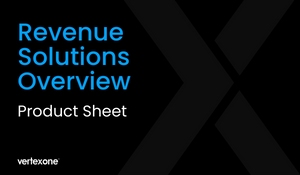INTRODUCTION - TRANSITIONING TO CLOUD
As customer expectations drive the need for new solutions, utilities of all sizes find it increasingly difficult to keep up with the pace of technology innovations. In addition, implementing new systems and solutions into legacy environments leads to a whole new world of complications, which then leads to a number of headaches for IT directors and C-level execs.
In addition to high downtime costs, retired mainframe platforms can’t integrate with new technologies, such as advanced meter infrastructures or multichannel capabilities. With transactional-centric cores, retired mainframes simply can’t keep pace in a utilities market that now requires more complex, customer-centric platforms.
/Improving%20the%20Customer%20Experience%20with%20Cloud%20Technology%2c..%20VertexOne.png?width=317&height=410&name=Improving%20the%20Customer%20Experience%20with%20Cloud%20Technology%2c..%20VertexOne.png)
And, in many utilities, members of the legacy system support staff are nearing retirement. To update internal systems, companies face a harrowing path. Organizations undertake great risks as they attempt costly and time-consuming implementations of new technologies – including those that are designed to improve customer experience. Forrester predicted that 25% of IT projects in the U.S. go over budget, while 34% run behind schedule. 1
Legacy technology also add another layer of challenges to IT staffs, including: High operation and maintenance tasks A lack of scalability in operations Difficulties in adding new features No bandwidth to add new technologies For many companies, moving to cloud software is a better alternative. A fully hosted and managed customer experience platform allows everyone from tier one to mid-size utilities to deliver a first class customer experience with far less budget and staff required for a traditional implementation.
EASE OF MIGRATION - REASON #1
With cloud technology, companies can now skip the traditional implementation altogether. Cloud service providers manage and protect your systems, freeing you from the need to buy hardware and software licenses or even manage an integration. From hosting systems to scaling growth, checking performance, supporting overall system health – a cloud service provider protects all the elements at play within an organization’s hosted environment. In a traditional implementation, utilities re-assign their best and brightest IT personnel to run the project – which could stretch on for months.
This takes key individuals away from important tasks. However, a migration to cloud-based technology significantly lowers the impact on your IT staff by greatly reducing the burden of project management. As a result, utilities can save themselves time and money compared to a traditional implementation. The biggest bonus is that utilities get to stay focused on their core business of keeping customers happy, both during and after the upgrade. Especially since the cloud service provider hosts and manages the technology on the utility’s behalf.
Utilities that choose cloud over traditional implementations experience a cost reduction of at least 40%. Your customers also reap the rewards of faster upgrades.
With a cloud software, you can:
- Migrate onto a new CIS platform, or add new customer experience capabilities, in half the time of a traditional implementation with less risk and cost
- Focus on your core business rather than a costly and time-consuming implementation
- Easily scale your systems, features, and functions to match growing needs and ensure an improved customer experience at a low cost to serve
IMPROVED OPERATIONS - REASON #2
On-premise solutions take a lot of upkeep to maintain security, compliance, updates, and support. With cloud technologies, however, companies have a dedicated provider that will host, scale, update, and support systems, as well as ensure performance. This ease of operation means you can focus more on your customers and less on your systems.
Business is driving the adoption of cloud technology because it simplifies the process of activating new capabilities. Utilities are adding AMI (Advanced Metering Infrastructure) and the ability to increase the channels through which customers can self-serve. Additionally, utilities are upgrading to software that allows them to better understand the voice of their customer through the voice of analytics, which offers them a unique advantage.
Adding predictive analytics allows companies to target and tailor communications, which makes it easier to enroll customers in self- service and energy efficiency programs. These add-ons have the power to significantly improve a customer’s overall experience with their utility company.
When it comes to costs, cloud technology offers something traditional implementations cannot: predictability. Cloud solutions give utilities lifetime certainty of TCO (Total Cost of Ownership), while traditional implementations tend to focus only on the cost to implement. And per the Forrester study mentioned earlier, they often run over schedule and budget.
The operational benefits of cloud technology are:
- Implementation time is cut in half, so you can go live faster and benefit sooner from the new capabilities
- Predictable, lower TCO, freeing up resources to invest in infrastructure
- Built-in business continuity that helps avoid costly downtime
- Set, long-term pricing models that allow companies to easily plan IT spending for up to 5 years in advance
- Greater efficiency and utilization of internal resources
- Built-in software upgrades to keep functionality up to date
SCALABLE GROWTH - REASON #3
To survive in the utilities marketplace, utility companies need to be able to quickly adapt to new business needs. Due to its scalability, cloud software has become the ideal platform to keep pace with ever- evolving business requirements and growing operations.
Should a utility undergo rapid growth and require support, they can easily scale up existing applications and add new applications as needed, on demand. This is a major advantage over companies that follow traditional computing models – models that require the purchase and implementation of new hardware and software to accommodate new demands.
In terms of functionality, cloud software allows companies to add a variety of new capabilities such as multichannel, customer enrollment analytics, debt collection analytics, and more. This flexibility allows a company to tailor their cloud environment to their utility’s and their customers’ needs. Need additional components? Then you have the option to add – seamlessly and quickly. In traditional environments, this would take far more time and effort.
Overall, the agility of cloud technology allows businesses to quickly adapt to customer needs and deliver a better customer experience – all without having to implement additional in- house hardware or software.
Every utility must respond to customer expectations and regulatory demands. Now, big utilities aren’t the only ones with access to the best customer experience technology. With cloud software, utilities of all sizes can interact with customers on their preferred channels, anticipate their needs, and empower them with new programs and initiatives.




